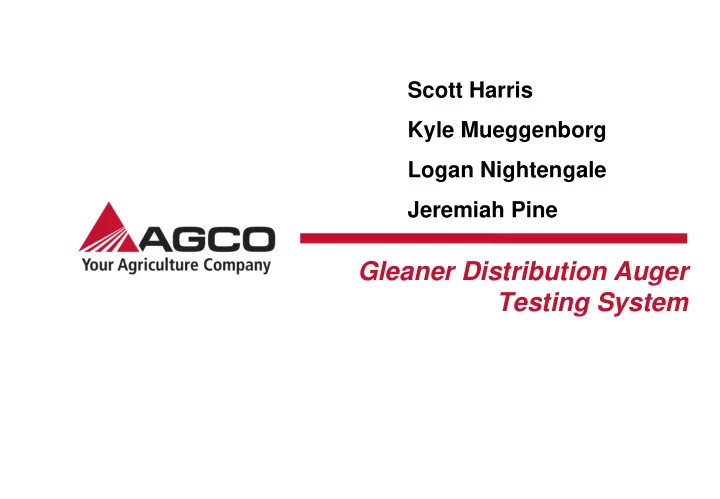

Scott Harris Kyle Mueggenborg Logan Nightengale Jeremiah Pine Gleaner Distribution Auger Testing System
Agenda 1 Background 2 Design 3 Testing 4 Results and Conclusions 1
Gleaner S77 2
Gleaner Transverse Combine 3
Project Objectives Develop effective testing apparatus using current Gleaner assemblies Determine baseline performance of production augers Determine alternative solutions for improving distribution Test alternative distribution techniques Analyze the performance of each alternative parameter Suggest the best solution based on experimental data collected 4
Assumptions Testing apparatus accurately reflects the conditions of material entering the distribution augers found in the field New design shows improved distribution of material as it exits the accelerator rolls based on data collected during testing Alternate design is compatible with current production cleaning system Augers will perform the same in straw only, and grain and straw mixture New design cannot exceed current diameter due to space constraints 5
Patent Search We found six patents pertaining to our project dating from 1979 to 1990 – 4180081 – 4444208 – 4457316 – 4458697 – 4716908 – 4906218 AGCO owns all six of the patents Only type of distribution system used amongst all other competitors 6
TestingApparatus AGCO provided the grain cleaning unit out of an S77 to use during testing Rotor was left out for improved observation of augers in action A stand for the unit was designed based on mass, size, and dynamic stresses 7
TestingApparatus Design Analysis Equations 8
TestingApparatus Power Transmission – Using power and speed diagram provided, motors and speed were determined – 10 Hp motor for powering accelerator rolls – 5 Hp motor for powering front distribution auger – Power Take off from a tractor supplied power to rear auger V-Belts were used to transmit power from electric motors V-Belt design was performed using Shigley’s Mechanical Design 9
TestingApparatus V-Belt Design Calculations Parameter Description Equation R Reduction ω N DriveN Speed (RPM) L p Pitch Length (in.) H d design power (hp) H a power allowable (hp) V belt speed (ft/min) N b number of belts 10
Testing Apparatus 11
Testing Apparatus 12
Material Feeding System Material conveyor was based off of a design observed at AGCO Conveyor needed to be elevated in order to properly introduce material A high coefficient of friction on the tarp was required to keep material from sliding Lovejoy connection and hydraulic motor were used to power the conveyor A strengths analysis similar to the test stand was performed on the conveyor system as well 13
Material Feeding System Material introduction system used by AGCO to test feeder houses 14
Material Feeding System 15
Build Materials Quantity Estimated Cost Total 3x3 Tubing ($/ft) 57 $7.42 $422.91 2x2 Tubing ($/ft) 160 $3.29 $527.04 1x1 Square Tubing ($/ft) 4 $1.03 $4.11 16 Gage Sheet Metal 2 $79.20 $158.40 14 Gage Sheet Metal 2 $99.00 $198.00 1 in Strap ($/ft) 10 $0.86 $8.60 Pillow Block Bearings 2 $13.95 $27.90 Ply Wood 1 $15.00 $15.00 Conveyor Drum 1 $20.00 $20.00 Labor 1 $250.00 $250.00 Power Transmission Supplies 5 HP Motor 1 $495.95 $495.95 Motor Starter 1 $95.99 $95.99 10 HP Pulley 1 $40.95 $40.95 Accelerator Roll Pulley 1 $28.95 $28.95 5 HP Pulley 1 $20.95 $20.95 Distribution Auger Pulley 1 $52.95 $52.95 Key Stock 1 $15.00 $15.00 Drive Line 1 $199.99 $199.99 Hydraulic Hose Tip Male 2 $10.99 $21.98 Hydraulic Hoses 2 $11.99 $23.98 Miscellaneous Conveyor Tarp 1 $100.00 $100.00 Straw 3 $0.00 $0.00 Grain 2 $0.00 $0.00 Final Predicted Total $2,728.65 Final Total Spent $2,367.86 16
Testing Methods Use of supplied testing apparatus to establish baseline performance Material was measured and dispersed on tarp before entering the distribution augers Bins were placed below the accelerator rolls to collect material Material flow rate was determined to be 25 tonne/hour Flow rate of material during testing was calculated based on conveyor 17
Flow Rate Calculations Parameter Description Equation Q mog Material other Grain Flowrate (tonne/hour) Q a Actual Flowrate (lb/s) Q c Flowrate produced by conveyor (lb/s) *v = velocity of combine, b = bushels/acre, w = width of header *C1 = conversion (2204 lb/tonne), C2 = conversion (3600 sec/hr) *Wm = weight of material (lb), t = time to spool conveyor (sec) 18
Testing Variables Speed of rear distribution auger was manipulated after initial tests Effect of speed on distribution performance was evaluated Plate covering right side of auger was removed in final trial Performance impacts with plate removed were also analyzed 19
Testing Methods Continued 20
Testing Video 21
Data Collection Numbered bins placed below accelerator rolls to catch material Bins were weighed before and after each trial run Based on difference in weight, amount of material was calculated Weights were recorded into a table for evaluation 22
Data Collection 23
Data Collection 24
Data Analysis 25
Conclusions Objectives Achieved: – Designed and fabricated effective, repeatable testing method – Successfully evaluated performance characteristics – Performed testing for alternative parameters – Provided suggestions based on testing of alternative solutions 26
Recommendations A change in flighting on the augers. Installing a canopy over part of the test stand if grain is used to test. Installing a more permanent way to keep the tarp out of the augers 27
Acknowledgements Joe Biggerstaff Craig May Dr. Daniel Thomas Dr. Paul Weckler Wayne Kiner Dr. Randy Taylor 28
Questions? 29
Recommend
More recommend